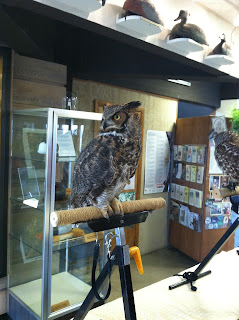 |
| Cooper's Hawk |
Our trip to Navarre Marsh this past Sunday made me feel like a birder with a VIP pass. Not only did we have many experts on hand to help us with any bird related questions, but we were birding in a location that is only open to outsiders a couple times a year. Navarre Marsh is located right next to the Davis-Besse Nuclear Power Station. The answer to your question is no. I did not see any birds with four eyes. There were more than a few birders, however, for which the moniker may have been appropriate.
 |
| Zoom in on the American White Pelicans |
The field trip was an all around success. In addition to the American Bittern, we were able to spot a Black-crowned Night Heron, an Eastern Kingbird, a Blackpoll Warbler, and a first of the year Yellow Warbler. Although we saw them in Florida at very close range, it was still cool to see two American White Pelicans soar over the marsh. A Yellow-throated Warbler was also spotted, but I unfortunately was on the far end of the line of people looking at the bird and did not see it. The day was capped off by an extra close up view of a second year Cooper’s Hawk. The bird had been found in the nets at the banding station located at the marsh. Ryan Steiner of the Black Swamp Bird Observatory held onto the feisty bird as many in the group snapped photos and listened to Kenn Kaufman and Mark Shieldcastle explain some of field marks. Cooper’s Hawks are difficult to identify due to the fact that a Sharp-shinned Hawk is nearly an identical twin. Big Year rules don’t allow me to count a captured bird, even after you see it released. Even if that weren’t the case I don’t think I would count it anyways. It would feel like cheating.
I know I’ve said this before, but the first two weeks in May can offer some of the best birding in Northwest Ohio. This is why the Black Swamp Bird Observatory holds The Biggest Week in American Birding Festival from May 3 to May 12. Think birding isn’t popular? Take a trip out to Magee Marsh sometime during the next two weeks. BSBO and other organizations have not only popularized birding through this event, but they have continued to bring more and more dollars to area businesses year after year. Perhaps if we need another economic stimulus package President Obama would consider the enormous potential of birding as fuel for an ailing economy.
Please check out all the activities that are offered during the Biggest Week. There are an unbelievable number of options offered during the festival. I will be volunteering on May 4 and May 5 as a driver for a couple of the tours. I am very excited about this, and I hope you make a point to get out and enjoy the birds during this very optimal time of the year. Happy birding!
Bird Count: 189
Recent Notables: Chimney Swift (Greenlawn Cemetery, Delta)








